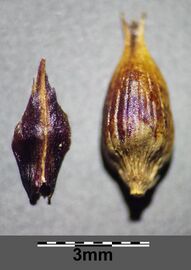Biology:Perigynium
In botany, a perigynium (plural: perigynia), also referred to as a utricle, typically refers to a sac that surrounds the achene of plants in the genus Carex (Cyperaceae).[1][2] The perigynium is a modified prophyll, also known as a glume, which is tissue of leaf origin that encloses the dry, one-seeded achene.[3]
In liverworts, "perigynium" refers to a tube-shaped structure which encases the archegonium and the developing sporophyte.[4]
The location, size, shape, hairiness, color, and other aspects of the perigynium are important structures for distinguishing Carex species.[5] They are often subtended by a scale, which may also aid in identification.[5]
Dispersal
Features of the perigynium may aid in seed dispersal, such as a surface that clings to fur or skin[6] or a shape that enables dispersion via wind or water.[7] Seed dispersal by animals such as ants (myrmechory) has been recorded, as some species of sedges have developed elaiosomes at the base of the perigynia. Ants carry the perigynium back to the nest, use the elaiosome for food, and the seed germinates away from the parent plant.[8]
Carex buxbaumii (green perigynia in center and on right, with dark brown scales)
Carex melanostachya (scale on left, perigynium on right)
Carex michelii (scale on left, perigynium on right)
Carex hirta perigynia
Perigynium vs. utricule
The terms perigynium and utricle have been widely used interchangeably.[9] In North America, the term perigynia is preferred, while utricle is more commonly used in Europe.[9] After the merging of Kobresia under Carex, a terminological clarification was desired, as the open prophyll of Kobresia could not be assimilated to the concept of utricle, which etymologically implies closure. The authors of a 2016 paper recommended using perigynium to refer generically to the flower prophyll of Carex sensu lato (including former Kobresia), but calling it utricle when it has its margins fused so it is entirely closed (as in the vast majority of Carex species).[9]
References
- ↑ Harris, James G. (2001). Plant Identification Terminology: An Illustrated Glossary (2nd ed.). Payson, Utah: Spring Lake Publishing. p. 131. ISBN 0-9640221-6-8.
- ↑ Wilhelm, Gerould; Rericha, Laura (2017). Flora of the Chicago Region: A Floristic and Ecological Synthesis. Indiana Academy of Sciences.
- ↑ Robert H. Mohlenbrock; Paul Wayne Nelson (1999). "Introduction". Sedges: Carex. Volume 14 of The Illustrated flora of Illinois. Southern Illinois University Press. pp. 3–7. ISBN 978-0-8093-2074-5. https://books.google.com/books?id=1ZGekaNQ4YAC&pg=PA3.
- ↑ "A Grammatical Dictionary of Botanical Latin". http://www.mobot.org/mobot/latindict/keyDetail.aspx?keyWord=perigynium.
- ↑ 5.0 5.1 "Carex". https://michiganflora.net/genus.aspx?id=Carex.
- ↑ Carter, R. 1993. Animal Dispersal of the North American Sedge, Cyperus plukenetii (Cyperaceae). American Midland Naturalist, Vol. 129, No. 2. pp. 352-356.
- ↑ ABUDUREHEMAN, B.; CHEN, Y.; LI, X.; ZHANG, L.; LIU, H.; ZHANG, D.; GUAN, K. (29 March 2018). "Patterns of Reproductive and Seed Dispersal and Ecological Significance of the Clonal Spring Ephemeroid Plant Carex physodes in the Gurbantuggut Desert". Planta Daninha 36. doi:10.1590/s0100-83582018360100007.
- ↑ Handel, S.N. 1976. Dispersal ecology of Carex pedunculata (Cyperaceae), a new North American myrmechore. Amer. J. Bot. 63 (8): 1071-1079.
- ↑ 9.0 9.1 9.2 Jiménez-Mejías, Pedro; Luceño, Modesto; Wilson, Karen L.; Waterway, Marcia J.; Roalson, Eric H. (1 September 2016). "Clarification of the Use of the Terms Perigynium and Utricle in Carex L. (Cyperaceae)". Systematic Botany 41 (3): 519–528. doi:10.1600/036364416X692488.
 |






